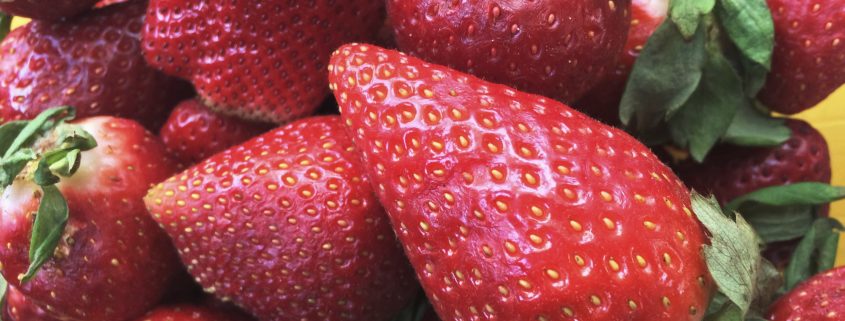A Juicy Bite at Health
 Strawberries are among the most eaten fresh fruits enjoyed in the United States, so it is no wonder why today, February 27, is National Strawberry Day. While strawberries are available for fresh picking across the country, most of the strawberries you will buy from a grocery store will be from California or Florida due to their warm climates. This means that strawberries are available in stores throughout the whole year, although peak season runs April through June. Depending where you live, during peak season you can head to a local farm to pick your own fresh strawberries!
Strawberries are among the most eaten fresh fruits enjoyed in the United States, so it is no wonder why today, February 27, is National Strawberry Day. While strawberries are available for fresh picking across the country, most of the strawberries you will buy from a grocery store will be from California or Florida due to their warm climates. This means that strawberries are available in stores throughout the whole year, although peak season runs April through June. Depending where you live, during peak season you can head to a local farm to pick your own fresh strawberries!
What makes strawberries so popular? Strawberries are bright red with edible seeds on the outside. They are sweet, juicy, and versatile in the kitchen. Not only are they delicious to enjoy fresh, they can be used in smoothies, salads, baked goods, and more. Their sweet flavor pairs nicely with other fruits plus savory flavors such as balsamic vinegar.
From a nutrition standpoint, strawberries have a lot to offer. To start, a one cup serving of whole strawberries contains around 45 calories, 220 milligrams of potassium, 3 grams of dietary fiber, 7 grams of sugar, and no fat, cholesterol, or sodium. Strawberries are considered heart healthy due to the fiber which has been related to reduced risk of heart disease. Potassium not only plays a role in maintaining a healthy blood pressure, it is also important for muscle contractions and maintaining electrolyte balance.
Strawberries are loaded with antioxidants and phytonutrients, including vitamin C and anthocyanins. Did you know that strawberries contain more vitamin C than an orange? A medium orange contains around 70 milligrams of vitamin C, about 117% the daily value. One cup of whole strawberries contains about 85 milligrams of vitamin C! That’s about 142% the daily value of 60 milligrams.
Due to their antioxidant properties, strawberries are considered to promote health and reduce the risk of age-related changes in cognitive function and possibly cancer.
It should be mentioned that strawberries are on the “Dirty Dozen” list of produce that are most often treated with pesticides. You are always advised to wash your produce well before using them, especially non-organic brands. For a quick produce wash that you can make in your kitchen, mix 3 parts water with 1 part white vinegar. Either soak your produce in the solution for about 20 minutes or use a spray bottle to spray them down. Don’t forget to rinse them off after. This cleaner will not affect the taste but it will make your food clean to eat and possibly help extend their freshness.
Your turn to take action: Pick up a carton of strawberries and enjoy them in a smoothie, a bowl of oatmeal, or however else you desire. Don’t forget to try this produce wash – it will soon be a favorite in your kitchen!


Leave a Reply
Want to join the discussion?Feel free to contribute!